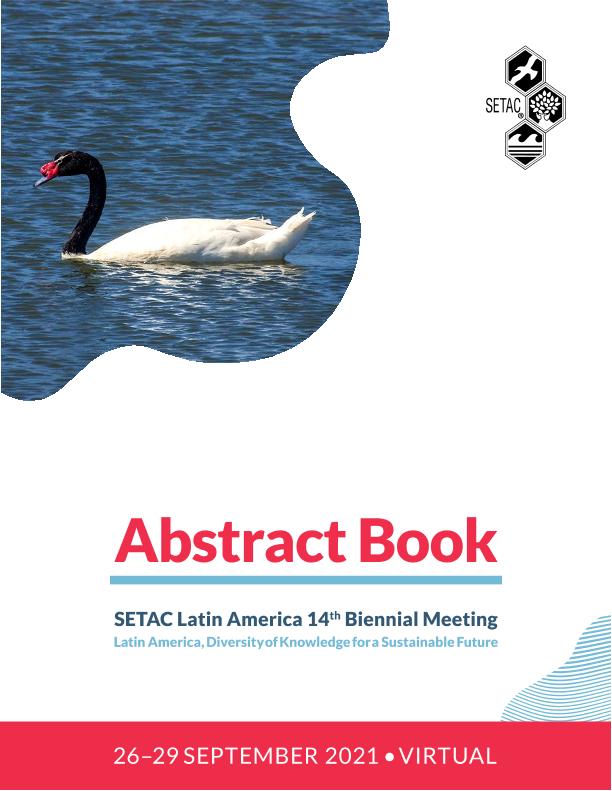Mostrar el registro sencillo del ítem
dc.contributor.author
Heredia, Belen
dc.contributor.author
Tapia Balmaceda, Raúl Esteban

dc.contributor.author
Rizzo, Pedro Federico

dc.contributor.author
Young, Brian Jonathan

dc.contributor.author
Roqueiro, Gonzalo

dc.date.available
2022-10-19T18:11:26Z
dc.date.issued
2021
dc.identifier.citation
Evaluation of soil pollution caused by waste accumulation from an abandoned gold mine 50 years ago in La Planta, San Juan, Argentina; Latin America 14th Biennial Meeting; Estados Unidos; 2021; 97-98
dc.identifier.uri
http://hdl.handle.net/11336/174003
dc.description.abstract
Metal accumulation is the main soil pollution caused by abandoned gold mines.Metal(loid)s are not biodegradable and have high persistence in the environment. Theobjective of this study was to evaluate the degree of contamination generated by miningwaste in La Planta, San Juan, Argentina. Ten soil samples were randomly taken at twosampling sites: contaminated (S1) and reference sites (S2). A physicochemicalcharacterization was carried out. Total, mobilizable and soluble concentration of Cu,Cd, Zn, and As was determined. The Geoaccumulation Index (Igeo), ContaminationFactor (CF) and Contamination Degree (Cdeg) were calculated to know the pollutiongenerated by mining waste. Total concentration of metal(loid)s was contrasted withguideline values for residential and agricultural use (Argentine Law no. 24,051). Anacid pH (=3) was recorded for S1 and slightly alkaline pH (=8) was recorded for S2. ECwas 8 times higher in S1, reaching a maximum value of 41.2 mS cm -1 . Essentialnutrients were less concentrated in S1. Total concentration of Cu, Cd, Zn, and As wasstatistically higher in S1 (p<0.001). The mobilizable and soluble fractions were 7 to38% of the total metal(loid) concentration in S1. While in S2, the mobilizable fractionwas 12 to 38% of the total concentration, and the soluble fraction was not detected. Theconcentrations of metal(loid)s were below the reference levels for both agricultural andresidential use in S2, while they were between 1 and 300 times above the referencelevels in S1. The highest concentrations were obtained for Zn (7123 mg kg -1 ) and As(6516 mg kg -1 ) in S1. A positive correlation was obtained between EC and the threefractions of the metal(loid)s in S1 (R>0.7; p<0.001). The pH correlated negatively withthe total and soluble fraction of As, and the mobilizable fraction of Zn (R>-0.7;p<0.001). Igeo reached values higher than 5 for As, Cd and Zn in S1, categorized asvery strong contamination and Cu corresponds to the category uncontaminated tomoderately contaminated. Using CF values, S1 was classified as very highcontaminated site for all four metal(loid)s. Values of Cdeg showed the highest categoryof contamination. Results indicate that soil is contaminated with at least Cu, Cd, Zn andAs in La Planta, showing the need to carry out a remediation plan. We conclude thatsoil pH should be regulated in order to reduce the bioavailability of metal(loid)s andpromote plant growth.
dc.format
application/pdf
dc.language.iso
eng
dc.publisher
Society of Environmental Toxicology and Chemistry

dc.rights
info:eu-repo/semantics/openAccess
dc.rights.uri
https://creativecommons.org/licenses/by-nc-sa/2.5/ar/
dc.subject
METALOIDS
dc.subject
ACCUMULATION
dc.subject
ENVIRONMENTAL RISK
dc.subject
GOLD MINES
dc.subject.classification
Otras Ciencias de la Tierra y relacionadas con el Medio Ambiente

dc.subject.classification
Ciencias de la Tierra y relacionadas con el Medio Ambiente

dc.subject.classification
CIENCIAS NATURALES Y EXACTAS

dc.title
Evaluation of soil pollution caused by waste accumulation from an abandoned gold mine 50 years ago in La Planta, San Juan, Argentina
dc.type
info:eu-repo/semantics/publishedVersion
dc.type
info:eu-repo/semantics/conferenceObject
dc.type
info:ar-repo/semantics/documento de conferencia
dc.date.updated
2022-09-14T16:09:15Z
dc.journal.pagination
97-98
dc.journal.pais
Estados Unidos

dc.description.fil
Fil: Heredia, Belen. Instituto Nacional de Tecnología Agropecuaria. Centro Regional Mendoza - San Juan. Estación Experimental Agropecuaria San Juan; Argentina
dc.description.fil
Fil: Tapia Balmaceda, Raúl Esteban. Consejo Nacional de Investigaciones Científicas y Técnicas. Centro Científico Tecnológico Conicet - Mendoza; Argentina. Instituto Nacional de Tecnología Agropecuaria. Centro Regional Mendoza - San Juan. Estación Experimental Agropecuaria San Juan; Argentina
dc.description.fil
Fil: Rizzo, Pedro Federico. Instituto Nacional de Tecnología Agropecuaria. Centro de Investigación en Ciencias Veterinarias y Agronómicas. Instituto de Microbiología y Zoología Agrícola; Argentina
dc.description.fil
Fil: Young, Brian Jonathan. Instituto Nacional de Tecnología Agropecuaria. Centro de Investigación en Ciencias Veterinarias y Agronómicas. Instituto de Microbiología y Zoología Agrícola; Argentina
dc.description.fil
Fil: Roqueiro, Gonzalo. Instituto Nacional de Tecnología Agropecuaria. Centro Regional Mendoza - San Juan. Estación Experimental Agropecuaria San Juan; Argentina
dc.relation.alternativeid
info:eu-repo/semantics/altIdentifier/url/https://www.setac.org/store/viewproduct.aspx?id=19048710#:~:text=This%20book%20comprises%20the%20abstracts,and%20appear%20in%20numerical%20order.
dc.relation.alternativeid
info:eu-repo/semantics/altIdentifier/url/https://cdn.ymaws.com/www.setac.org/resource/resmgr/abstract_books/SLA-14-abstract-book.pdf
dc.conicet.rol
Autor

dc.conicet.rol
Autor

dc.conicet.rol
Autor

dc.conicet.rol
Autor

dc.conicet.rol
Autor

dc.coverage
Internacional
dc.type.subtype
Reunión
dc.description.nombreEvento
Latin America 14th Biennial Meeting
dc.date.evento
2021-09-26
dc.description.paisEvento
Estados Unidos

dc.type.publicacion
Book
dc.description.institucionOrganizadora
Society of Environmental Toxicology and Chemistry
dc.source.libro
Abstract Book: Latin America 14th Biennial Meeting
dc.date.eventoHasta
2021-09-29
dc.type
Reunión
Archivos asociados
